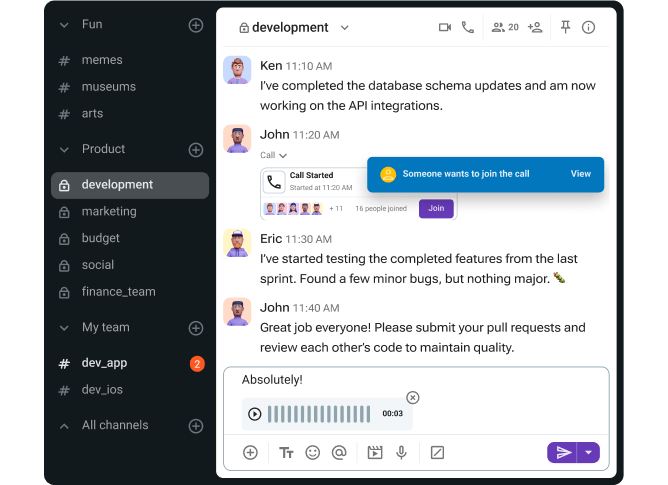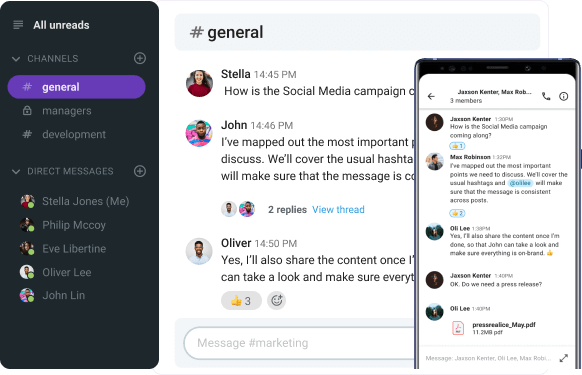Effective communication is arguably one the most essential requirements for a productive workplace.
According to Pumble’s Workplace Communication Statistics in 2025, when teams communicate effectively, their productivity may increase by 25%.
On the other hand, according to a recent report from Axios HQ, communicating poorly can cost a business anywhere between $10,000 and $55,000 per employee per year, depending on their annual salary.
But why is it so easy for misunderstandings to come up, and is there a way to avoid miscommunication in the workplace?
In this article, we will help you deal with miscommunication by:
- Providing insight into what miscommunication is and what effects it can have in the workplace,
- Covering its most common causes, and
- Providing examples and tips for recognizing and solving miscommunication in the workplace.
Ready? Let’s get started.

Table of Contents
What is miscommunication in the workplace?
Miscommunication in the workplace occurs when coworkers convey the message poorly or misinterpret the intent and meaning of the message conveyed to them.
Unfortunately, this can potentially lead to internal conflicts and employee dissatisfaction.
In terms of frequency, miscommunication happens more often than you probably think.
According to research by Notta, a whopping 100% of surveyed business leaders and knowledge workers experience miscommunication at least once a week.
Even though you might be tempted to think that everything gets sorted out in the end, long-term miscommunication can have a profound effect on your business.
What are the effects of miscommunication in the workplace?
The effects of miscommunication are real and not to be taken lightly. Miscommunication in the workplace can lead to:
- Project failure — Altersquare’s research from 2025 shows that 56% of outsourced IT projects fail as a result of poor communication.
- Financial losses — 32% of business leaders have noticed the real financial impact of poor communication, according to Pumble’s Workplace Communication Statistics in 2025.
- Stress and burnout in employees — According to Project.co’s Communication Statistics 2025, 43% of people have suffered from burnout, stress, and fatigue as a result of communication issues.
Knowing the undeniable cost of miscommunication in the workplace, let’s try to unpack the most common causes of miscommunication.
What are the causes of miscommunication in the workplace?
Miscommunication in some form can happen during any type of communication situation at work.
In order to prepare for this possibility, let’s take a look at some of the main general causes of miscommunication in the workplace, so you can recognize and address them properly.
#1 Different communication styles
According to a Forbes article, 42% of survey respondents cited different communication styles as a leading cause of miscommunication at work.
The research Forbes cites is based on Mark Murphy and his team’s research, which recognized 4 distinct communication styles:
- Analytical — favoring hard data, numbers, and facts,
- Intuitive — focused on the big picture and the end goal without the “fluff”,
- Functional — primarily thorough, focused on process, details, and step-by-step plans, and
- Personal — guided by the emotional connection and relationships, valuing harmony and how people feel above all else.
Let’s try to put miscommunication due to different communication styles into perspective by examining a hypothetical scenario.
Let’s say an intuitive manager tells an analytical employee to come up with an app mockup to present to the upper management. The intuitive manager, who favors communication without “fluff,” gives the analytical employee directions without focusing on the details, just showcasing the broad idea.
Meanwhile, the analytical employee, who favors hard data and facts, might get confused as to how to see this through.
The intuitive manager might request an “initial framework mocked up and ready to go early next week”.
On the other hand, the analytical employee might pose questions like:
- “What data sets do I use?”
- “Can we define the precise date and time?”
- “What features do I include? All of the features are defined by very specific data.”
If impatient or too busy, the intuitive manager might even walk away thinking an agreement has been made, leaving the analytical employee confused.
One of the easiest solutions for major communication style differences like this is to consult a mediator — someone who will listen to both sides and try to find a compromise.
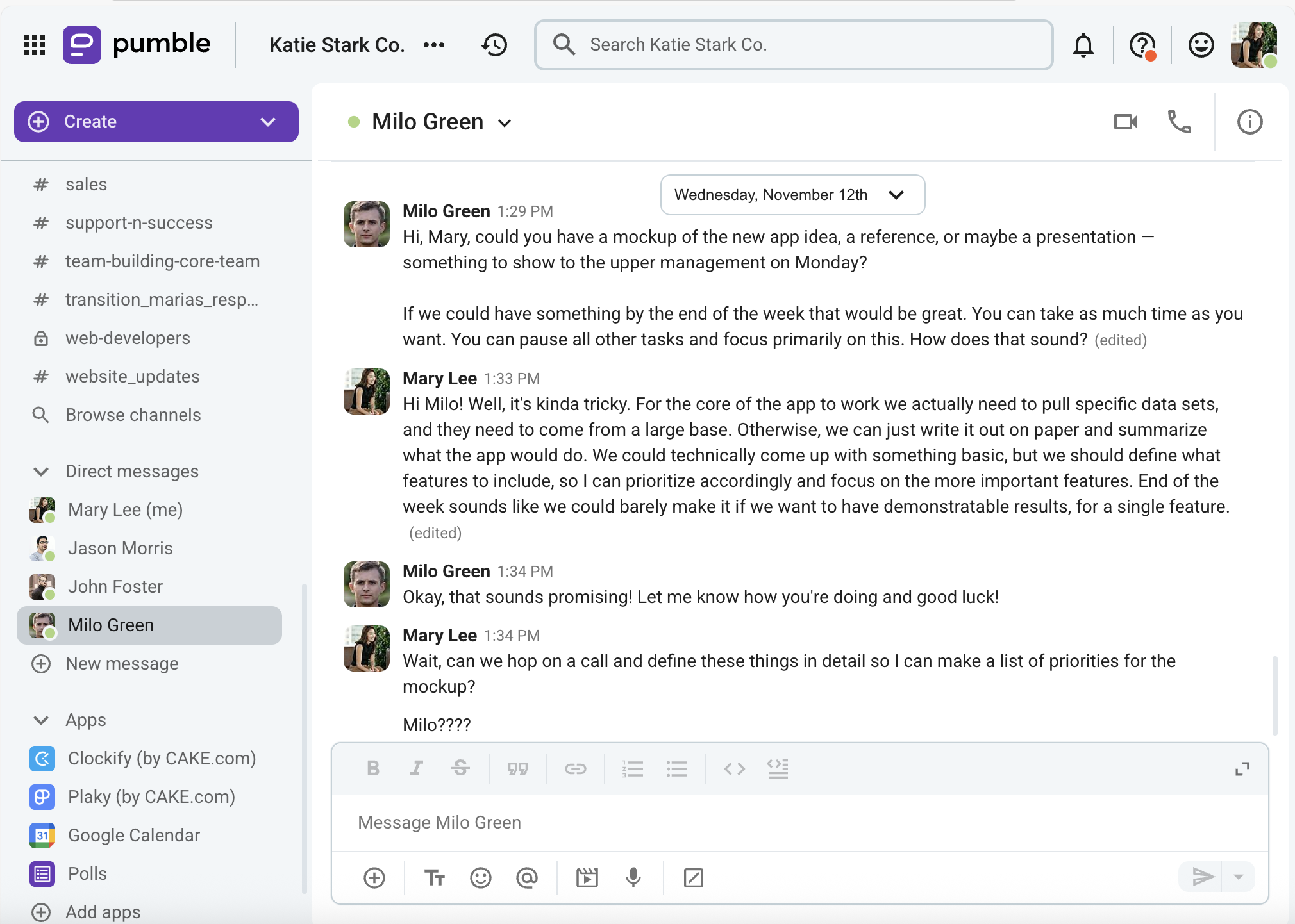
💡 Pumble Pro Tip
To learn more about the differences between various styles of communication, make sure to check out our comprehensive guide:
#2 Organizational silos
Organizational silos are another direct cause of miscommunication at work.
Organizational silos are unofficially isolated groups of employees that exclude team members or entire teams for various reasons. When teams operate in isolation like this, they create separate “information bubbles” or information silos.
This isolation often directly leads to several forms of miscommunication, such as:
- Misaligned priorities and goals,
- Development of different “languages” or business jargons,
- Withholding of information,
- Duplicated effort, and
- Tribal mentality full of mistrust.
Needless to say, this is a recipe for a catastrophically ineffective workplace, where miscommunication is an hourly occurrence.
The best way to deal with this hypothetical situation is to prevent silos from forming in the first place, by building a successful company culture that favors open, transparent communication.
💡 Pumble Pro Tip
If you’re struggling with silos structure in your workplace, you should check out our blog about identifying and breaking down this type of work communication:
#3 Psychological barriers
Psychological barriers can be temporary or persistent mental and emotional states that get in the way of effective communication.
They are often the result of a toxic workplace. According to The American Psychological Association, more than 15% of workers reported experiencing what they characterized as a somewhat or very toxic workplace.
Psychological barriers often stem from:
- Heightened feelings — Someone in a heightened emotional state (like anger, anxiety, or sadness) can interpret constructive feedback as an aggressive attack, especially if they are dealing with other external pressures.
- Past experiences — Low self esteem due to past experiences can impact communication in a negative way and introduce another set of problems. People struggling with this will either withhold opinions or perceive questions as an attack on their competence more often than realistic.
- A lack of trust — Fear and lack of trust also represent a psychological barrier and often introduce miscommunication. If there’s a history of blaming or negative consequences in the workplace, people will be scared to speak up or won’t believe they are safe to do so. Instead, they will intentionally filter or withhold information to protect themselves.
- A combination of these factors.
💡 Pumble Pro Tip
Psychological barriers represent only one of all possible communication-related obstacles at work. To look into minimizing misunderstandings from another perspective, check out our blog:
#4 Generational differences
As mentioned, one of the most common causes for miscommunication in the workplace is the difference in communication styles. Since modern companies are usually multigenerational environments, this is especially evident across generational divides.
Aside from preferring different communication channels, different generations simply communicate differently.
For instance, digital natives such as Millennials and Gen Z are often known to use emojis in professional settings, whereas other generations refrain from using them.
Paired with contemporary phrases the older generation may not be familiar with, the communication approach of a younger generation may sometimes lead to misunderstandings with older colleagues (and vice versa) — which can have negative effects on interpersonal relationships and business.

#5 Poor listening skills
Poor listening skills are also one of the primary causes of miscommunication because they create a gap between the message that is sent and the message that is received.
They can be accidental or a result of poor attention, but their effects are detrimental nonetheless. When we fail to listen properly, we aren’t just missing words, but also the full meaning, context, emotion, and intent.
This forces poor listeners to fill in the blanks with assumptions, and that’s exactly where miscommunication happens.
The most common types of poor listening that cause misunderstandings are:
- Selective listening — when the message receiver only hears what they want or expect to hear,
- Defensive listening — when a listener perceives innocent comments as personal attacks or criticisms,
- Interrupting or “monopolizing” — when a listener is so focused on their own response that they don’t let the speaker finish, and
- Pseudo listening — when a person appears to be paying attention (nods, makes eye contact, and sends signals of participating) but their mind is somewhere else entirely — they are hearing sounds but failing to process meaning.
To combat the effects of poor listening skills, the main goal should be for the listener to understand the fundamentals of active listening, after getting the hang of the basics.
💡 Pumble Pro Tip
To thoroughly study, develop, and master the fine art of active listening, make sure to read up on our blog post:
#6 Stereotyping and biases
One of the more obvious factors in miscommunication are unjustified assumptions known as stereotyping and conscious or unconscious biases.
Both of these can occur in a multitude of ways, but the one thing they have in common is that they represent mental filters that distort the message before it’s even fully received.
Instead of hearing what is actually said, listeners who stereotype hear what they expect to hear based on their internal assumptions. This creates a gap between reality and perception.
On the other hand, biases are unconscious shortcuts our brains use to make decisions faster. However, in communication, these shortcuts often lead us down the wrong path.
The most common types of biases in the workplace include:
- Confirmation bias — the tendency to only listen for and agree with information that confirms what we already believe.
- The halo effect or the horns effect — allowing our first impression of a person either good (“halo”) or bad (“horns”) to taint all of our future communication with them.
- Fundamental attribution error — the tendency to judge others by their perceived character while judging ourselves by our situation and context.
Unfortunately, there’s no easy fix for stereotyping and biases other than thorough extensive:
- Education,
- Team-building exercises, and
- Development of effective team dynamics.
#7 Cultural differences and lack of awareness
Since ever more companies are conducting business globally or have team members from all around the world, awareness about cultural diversity in the workplace is becoming even more relevant than before.
A lack of awareness can lead to misunderstandings. For instance, different cultures imply different holidays (among other things). Not being aware of that can lead to miscommunication, like the one shown in the example below.
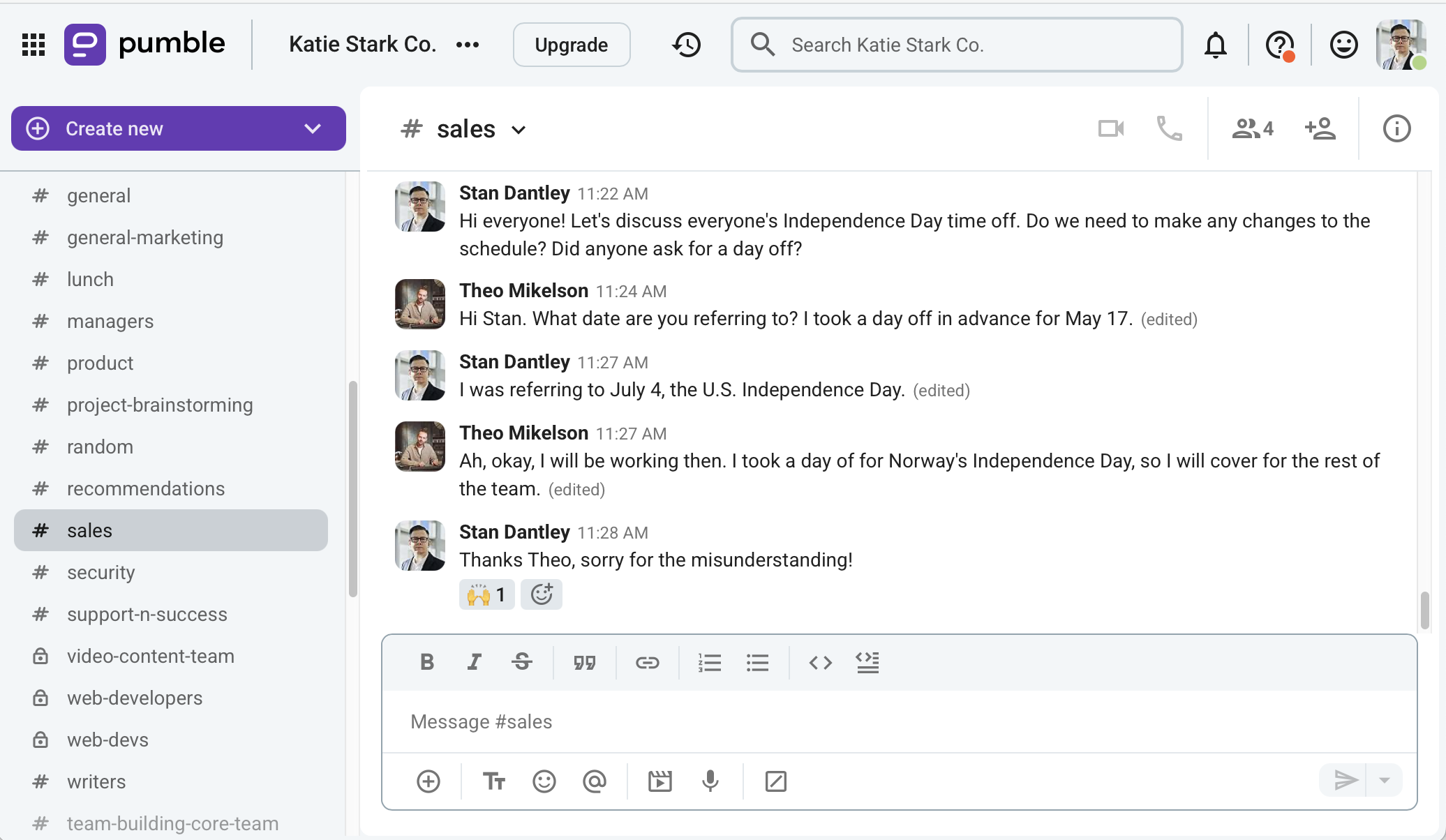
Connect your diverse workplace
When working in multicultural environments (virtual or not), we should take into consideration other cultures and make an effort to get familiar with their customs, traditions, and communication habits.
That is why effective cross-cultural communication is key to a better atmosphere in the workplace and a safe road to avoiding miscommunication.
#8 Undercommunication
Another major cause of miscommunication in the workplace is undercommunication.
Not having enough information about a project, task, or any other vital component of business life leads employees to assume what is going on. Apart from misunderstandings, this is also how rumors that spread through the grapevine are born.
On top of that, many undercommunication misunderstandings can easily be avoided, which makes them all the more frustrating.
For instance, take the example of remote teams who work in multiple time zones.
In their case, it’s important to explicitly state when a certain meeting will take place. Is the meeting at 9 a.m. CST or EST? These kinds of mix-ups are avoidable if you only pay more attention to communication in the workplace.
#9 Poor leadership
Finally, one of the most difficult miscommunication sources to handle is poor leadership. All of the causes of miscommunication we mentioned so far are further amplified coming from a leader.
Since effective downward communication starts from the managers, their job is to motivate their staff to be more productive and creative. They are expected to set the tone, standards, and systems for how information flows within a team.
Leadership has the ability to make or break the entire organization.
If there is a lack of successful downward communication, the objectives of the company may be unclear to the employees, which can demoralize them.
Here’s what poor leadership looks like as a primary miscommunication contributor:
- Lack of clarity and vague expectations — which most often stems from lack of plan,
- Information hoarding and lack of transparency — treating information as a source of authority and power,
- Creating a culture of fear — especially through public criticism or punishment,
- Avoiding difficult conversations and conflict at all costs, and
- Poor listening skills — which are especially amplified and frustrating when they are coming from someone in a position of power.
If these leadership errors occur, employees can be left feeling confused and unmotivated.
Sadly, there is no easy solution for this other than upper management stepping in or the problematic leader recognizing their weaknesses and working on them.
Now, with the biggest causes covered, let’s move on to the tips on how to avoid miscommunication in the workplace.
6 Tips on preventing miscommunication in the workplace
If you think you’re doomed to make mistakes that inevitably lead to miscommunication, don’t worry. There are some ways to avoid miscommunication altogether — here are the 6 best ones.
Tip #1: Never assume anything – overcommunicate instead
First of all, never assume anything.
Even though often frowned upon, it’s sometimes better to overcommunicate than to think we have communicated or understood everything necessary for effective team collaboration.
The trouble with assuming what other people think is the fact that we all have a different horizon of understanding, that is “the range of vision that includes everything that can be seen from a particular vantage point”.
This horizon depends on our previous experiences and helps us interpret new situations.
Since we don’t all share the same horizon of understanding, we can easily come to the wrong conclusions in conversations with our coworkers.
That’s why it’s crucial to overcommunicate with our colleagues, as well as put ourselves in their shoes.
Only then can we hope to grasp the true meaning of our colleagues’ words.
Tip #2: Pay attention to nonverbal communication
When conversing with our colleagues in physical space, it’s easier to take into account their body language and specific nonverbal cues. It’s important to pay attention to this part of communication if we want to avoid misunderstandings.
On the other hand, to avoid miscommunication in an online world, digital body language should not be neglected.
In our search for ways to solve workplace miscommunication, we reached out to Allie Gallinger, a speech-language pathologist.
She highlighted that nonverbal communication is often lacking in the modern workplace:

“If companies are using instant messaging and email as their primary method of communication, there is likely a lot of nonverbal communication being missed. To be more specific, one cannot see another person’s facial expression and body language and cannot hear a person’s tone of voice.”
This can lead to plenty of issues but it’s not an insurmountable obstacle, as she went on to explain:

“If you send or receive a message that simply says, ‘Thanks,’ without nonverbal communication, this can be interpreted as someone being angry. One way to solve this difficulty is to be explicit over instant messaging and email. Say what you mean, mean what you say, and use punctuation to make things very clear. Also, where possible, speak in person! It is much harder to have miscommunications when you can see and hear a person.”
For this very reason, it’s best to schedule either live meetings or online meetings with mandatory video. This way, you can take in the body language and subtle nonverbal cues of the people you are speaking to, which makes understanding communication nuances much more easy and often prevents miscommunication.
Hold video meetings with Pumble
Tip #3: Practice active listening
In her TedEd talk How miscommunication happens (and how to avoid it), Katherine Hampsten highlights the importance of active listening in an effort to avoid miscommunication.
Here are her tips:
- Passive hearing and active listening are not the same thing. We should adjust our message to the listener (or reader), to achieve better understanding.
- Listen with your eyes, ears, and guts. Don’t forget, communication is more than just words.
- Take time to understand as you try to be understood. We easily forget that communication is a two-way street.
- Be aware of your own perceptual filters. Your background, culture, community, and family influence how you see the world. Keep in mind that your perception is not necessarily objective truth.
If you follow this advice closely, you will be practicing active listening, which will help you avoid the majority of misunderstandings.
Tip #4: Master the art of clarity
One of the ways to avoid miscommunication is to openly discuss expectations with your coworkers.
Before you start a new project, you should set clear goals and schedules, so everyone can adjust their expectations. Then, you need to listen to all the questions from your coworkers and patiently answer them. Only once you’ve done that can you be sure that you’ve successfully avoided any misunderstandings.
Of course, you’ll have to keep communicating clearly throughout the entire project — especially if some changes come up. Change is always stressful, so make sure to aim to find the best way to communicate a change, regardless of what it is.
At the very least, you could reduce the negative feedback by taking your time to approach the situation carefully and being open to listening.
One of the ways you can foster clarity and transparency is to communicate to multiple people at once, through various communication channels — including business messaging apps.
This way, everyone will get notified simultaneously, and you can refine your future announcements by getting feedback immediately.
If there are any questions, it’s likely that at least one of your team members will ask for clarification. In turn, you will know if you need to work communicating more clearly.

Keep your team updated with Pumble
Tip #5: Choose the right communication channel
Choosing the right communication channel is a critical step in preventing miscommunication.
The core principle here is to match the channel to the message and its importance.
For example, although a quick DM in Pumble, a team communication app, works perfect for a quick update, it’s a terrible way to handle a sensitive performance review.
To avoid miscommunication, analyze your message in terms of sensitivity, complexity, and urgency.
Some general guidelines for choosing the most appropriate communication channel are:
- Use video calls or face-to-face meetings for highly sensitive and complex situations (e.g., performance reviews, brainstorming, conflict resolution, negotiations, etc.).
- Use audio or phone calls for urgent but moderately sensitive info (e.g., urgent problems, quick check-ins on a sensitive topic, or questions too long to type).
- Use DMs for urgent info low in complexity (quick questions, urgent updates, coordinating immediate tasks, etc.).
By choosing the most appropriate communication channel, you minimize the potential of confusing the recipient or creating an awkward situation by being too casual or unnecessarily formal.
Get an all-in-one communication app
Tip #6: Create feedback loops
A feedback loop is a process where the output (or feedback result) is captured and used as input to inform future feedback.
When implemented correctly, this method promotes constant development of individuals as well as teams.
To create a feedback loop, you have to:
- Define goals and actions. Determine what you are trying to achieve and what specific action or process you need to improve.
- Establish a collection method. Set up a way of gathering feedback on the result (one-on-one meetings, team check-ins, direct questions, surveys, etc.).
- Analyze the feedback. Look for patterns, insights, and interesting points. What is the feedback telling you?
- Adjust actions. Based on the analysis, determine what adjustments need to be made to the original action or process. What will you do differently next time and why?
- Implement changes and communicate. Put the changes into practice and communicate back what changes were made (or why they weren’t made).
- Repeat the cycle. Rely on the new experience and information that you gather from the beginning of this process.
Implementing changes and communicating is maybe the most crucial part of the process, as this is the part that actually “closes the loop” and shows people their input matters. This inspires them to contribute to your next feedback process.
By intentionally setting up these steps, you create a system for ongoing learning and improvement based on actual results and constantly improve your workplace.
💡 Pumble Pro Tip
To learn more about providing and asking for feedback in the workplace check out or blog posts:
Foster feedback culture with Pumble
Specific examples of miscommunication in the workplace
Apart from the forms we already covered, miscommunication at work can come in virtually endless shapes.
In order to better understand how miscommunication can show up, let’s take a look at some specific examples to make things even clearer.
#1: Unrecognized effort
Let’s say Tyler has been working on a really big project with his team for months. And even though Tyler is really pulling his weight, somehow, all his hard work still goes unnoticed.
On the other hand, Tyler’s colleagues are being praised every step of the way. This leaves him perplexed and with the need to reexamine his place in the team and the company.
How this can be miscommunicated: Tyler could say something like: “I do all the work and my colleagues get the credit.”
The real problem: Tyler is noticing that his colleagues are being recognized but he is being left out. Therefore, he is left wondering if he’s doing anything wrong and hoping for feedback.
How to make the message clearer: In order to get his point across more professionally, Tyler could say something like: “I’d like to be acknowledged and would like to get some honest feedback.”
How this should be handled: In this case, the manager should take a step back and analyze the situation. They should consider whether they really are overlooking one employee’s contribution to the team’s success. If so, it would be wise to show their appreciation for the employee’s hard work.
💡 Pumble Pro Tip
For more practical tips on how to make your employees feel seen and valued, read our blog post:
#2: Feeling undervalued
Anna has been working for the same company for 10 years. It is her dream job and she’s really putting herself out there and doing an amazing job.
Still, her managers are so used to the fact that she’ll always do her tasks on time and exquisitely, that they don’t make an effort to reward her in any way.
How this can be miscommunicated: Anna could say to her manager, “I’m working way too much for the amount I’m paid.”
The real problem: Anna feels undervalued and underappreciated while her hard work amounts to nothing.
How to make the message clearer: To frame this constructively, Anna could say something like:
- “I think I’m giving my best and would like to be compensated accordingly.”
- “I’d like to discuss my workload. Maybe we should delegate some of my tasks to others.”
How this should be handled: Anna’s manager should take a good look at Anna’s role in the company. If they don’t want to lose a valuable employee such as Anna, they should consider why she is dissatisfied.
According to research by Gallup, employees who do not feel adequately recognized are twice as likely to say they’ll quit in the next year.
In order to keep valuable workers, managers should give their best to make employees feel appreciated and valued.
#3: Feeling unmotivated
Imagine Greta. Greta is practically a wunderkind. Right after finishing her master’s degree, she got a job as a graphic designer in a very well-known company. However, 3 years have passed since, and she’s still getting tedious entry-level tasks.
How this can be miscommunicated: Greta could say something like: “I’m bored at my job.”
The real problem: Greta is an employee looking for more responsibility and opportunities for growth.
How to make the message clearer: Greta could frame her message as: “I think I could contribute more to this company. Would you consider giving me more demanding or challenging tasks?”
How this should be handled: This is maybe the easiest challenge for the manager to conquer, as they can:
- Include the employee in cross-functional teams,
- Give them a side project to work on, and
- Define the next steps the employee should take in order to advance their career.
When you show your employees there is room for growth, they will certainly be more motivated and engaged.
#4: Missing your purpose
Every single day, Mia goes to the same office and does the same job as a secretary of a big company.
Every single day, everything is the same — how she prepares her coffee, who she drinks it with, and where she sits while she does so (next to the window so she can look at the nearby park).
The same goes for her work. Despite some variation in her work and occasional pay raises and bonuses, all her tasks look alike. Because of this, Mia feels like she isn’t contributing in a profound way, but rather filling a position.
How this can be miscommunicated: Mia could say, “All this work is going nowhere.”
The real problem: Mia needs a vision and forward momentum.
How to make the message clearer: Mia could frame her dissatisfaction differently by saying, “I’d like to know more about company goals and plans, so I could do my job better.”
How this should be handled: The weight of this issue will most likely be on the company leader. The leader should inspire and give purpose and vision to their employees. When employees have a clear vision of their company, their own role in the process is clearer and that is a great incentive both for regular work and proactive work.
#5: Fear of delegating tasks
Diego is great at his job as a manager of a retail store. He supervises 10 employees in the store in a large shopping mall. However, his habit is to micromanage his team and even do their tasks, if he deems it necessary.
How this can be miscommunicated: By doing this, Diego is sending a strong message to his employees and saying, “It’s easier to do everything myself.”
The real problem: Diego is too scared to delegate.
How to make the message clearer: Given that Diego recognizes this as a problem, he could frame the situation differently by saying, “Sometimes it’s hard for me to delegate tasks to others, but I’m working on it. I’ll try to delegate more.”
How this should be handled: To avoid micromanagement, Diego should delegate his tasks and have faith in his subordinates. Although sometimes used to avoid responsibility and blame, delegation is necessary for better productivity. This way, time is used more effectively, and achieving set goals is easier.
Simplify delegating tasks with Pumble
💡 Pumble Pro Tip
For further reading on improving communication in your workplace, check out our expert articles:
Make use of Pumble to minimize miscommunication in the workplace
As we’ve established, clear communication is necessary to avoid misunderstandings and keep work smooth.
Luckily, we can rely on communication and collaboration tools that help us provide clarity where necessary. For this purpose, look no further than Pumble.
Pumble is a team communication app that helps you manage the most common causes of miscommunication, by doing the heavy lifting for you.
To start with, you can always post announcements and ask for clarification in channels, dedicated group spaces for subteams. This way, you can avoid any potential misunderstandings when it comes to task or duty details.
You can also send a direct message to your colleague for immediate feedback, so as not to overload the channel or thread with specifics only relevant to you, for example.

Other core Pumble features that can help you manage miscommunication at work include:
- Guest access — which allows you to temporarily invite external collaborators, give them access to the information they need, and always keep them in the loop.
- Threads — which are a great tool to keep discussions focused in one space and easy to follow,
- Unlimited messaging and search history — which allow your team to easily stay in sync, regardless of when you’re working, and
- Video calls — which are a communication channel best used for sharing important, high-stakes info.
Pumble also allows you to share your screen during video calls with other participants, making the idea-sharing process seamless. And, to reduce the chances of potential miscommunication even further, you can record your meetings and revisit them later to make sure you got everything just right.
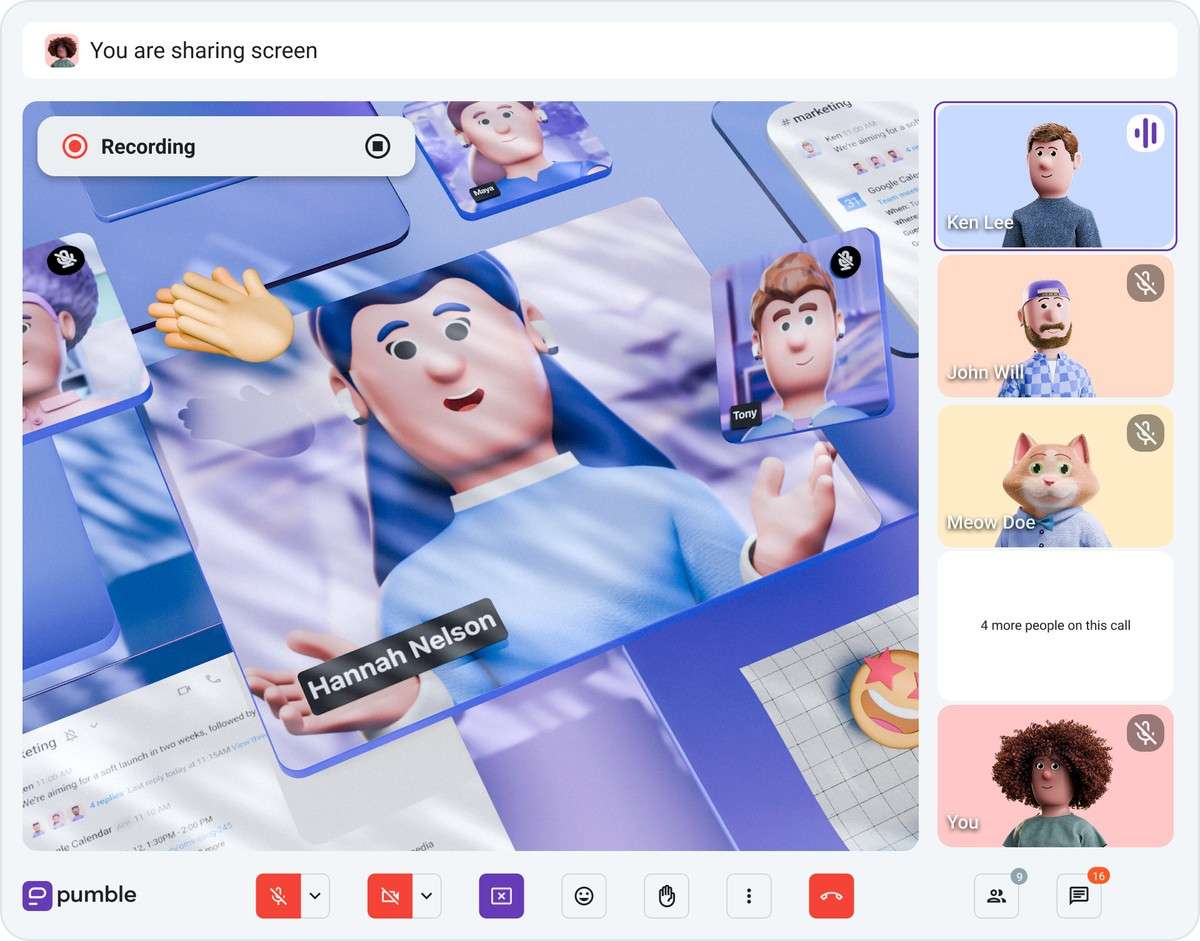
Pumble also lets you share files and even pin messages and files in channels. That makes all information easily accessible, thus preventing miscommunication even further.
Finally, if you ever need to jog someone’s memory about any particular topic but don’t want to disturb them during off hours, you can:
- Schedule messages to arrive at a time you set, or
- Set reminders to send the information at a later time.
Work and collaborate with no miscommunication — try Pumble for free today.
And if you’re looking to simplify work for everyone and eliminate miscommunication on all fronts, make sure to check out our project management tool, Plaky, and our time tracker, Clockify.
To seamlessly integrate all 3 tools and really supercharge your workflow, make sure to check out the CAKE.com Productivity Bundle.

